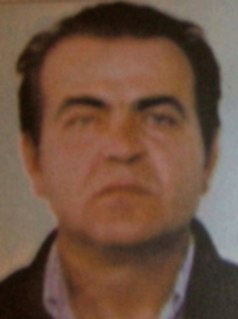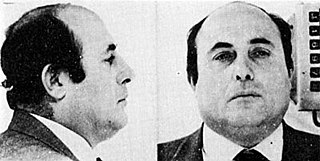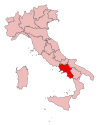Related Research Articles
The Camorra is an Italian Mafia-type organized crime syndicate, or secret society, originating in the region of Campania and its capital Naples. It is one of the oldest and largest criminal organizations in Italy, dating to the 17th century. Unlike the pyramidal structure of the Sicilian Mafia, the Camorra's organizational structure is divided into individual groups also called "clans". Every "capo" or "boss", is the head of a clan, in which there may be tens or hundreds of affiliates, depending on the clan's power and structure. Consequently, as Camorra clans act independently, they are more prone to feuding among themselves. The Camorra's main businesses are drug trafficking, racketeering, counterfeiting and money laundering. It is also not unusual for Camorra clans to infiltrate in the politics of their respective areas.
The Di Lauro clan is an Italian crime clan, part of the Camorra in Naples. The clan operates in the neighbourhoods of Secondigliano, Scampìa, Miano, Marianella, Piscinola, and in the adjacent municipalities of Casavatore, Melito, Arzano, Villaricca and Mugnano. The head of the clan is Paolo Di Lauro, from Via Cupa dell'Arco, in Secondigliano.

Giancarlo Siani was an Italian crime reporter from Naples, who was killed by the Camorra, the Neapolitan crime organization.
The Contini clan is a powerful Neapolitan Camorra clan operating in the city of Naples, and more specifically in the area of the Naples Central Station. The clan's traditional powerbase is the Arenaccia district. It also operates in the Poggioreale, Vasto, Mercato and San Carlo all'Arena suburbs of Naples. The clan is also active outside Italy, particularly in Barcelona, Spain, in Amsterdam, Netherlands and in Eastern Europe. The Contini clan is also one of the founding clans of the Secondigliano Alliance, that is considered by the authorities as the most powerful Camorra group that is still active.
The Scissionisti di Secondigliano is a Camorra clan from the Secondigliano district of Naples, headed by Raffaele Amato and Cesare Pagano. They are also known as "Spagnoli" (Spaniards) because of their strong presence in Spain, particularly in Costa del Sol and Barcelona. After the end of the war against the Di Lauro clan, the group fell apart, starting a violent internal war. In the present day the Scissionisti di Secondigliano are known as the Amato-Pagano clan.

Salvatore Lo Russo is a former member of the Camorra. Officially unemployed, Lo Russo was the head of the powerful Lo Russo clan, a Camorra clan, now defunct, that was based on its territory within the city of Naples, concentrated specifically in its stronghold of Miano. For over 30 years the Lo Russo's organization has extended its influence to numerous neighborhoods in the north of Naples, having branches in France and in Switzerland.

Raffaele Diana is an Italian Camorrista and senior boss of the Casalesi clan from Caserta. His nickname is Rafilotto.

Pasquale Russo is an Italian Camorrista and boss of the Russo clan from Nola, which he co-founded. He has been running the clan together with his brother Salvatore for over thirty years. He has been on the "most wanted list" of the Italian ministry of the Interior since 1995, for Camorra association, murder, concealment of corpse, multiple homicides, racketeering and other crimes. On February 15, 1996, an international warrant was issued against him, to be arrested for extradition.
The Russo clan is a Neapolitan Camorra clan operating in the town of Nola and its surrounding territories. Police say the Russo clan had total control over illegal activity in about 40 towns in the Naples region.

Luigi Esposito, also known as Celeste ("Sky-blue"), is an Italian criminal and a member of the Neapolitan Camorra.
The Secondigliano Alliance is a strategic alliance of Camorra clans in Naples and its hinterland which controls drug trafficking and the extortion racket in many areas of Naples since the 1990s. The Alliance has branches in the Netherlands and in Spain, where it has as main objective the international drug trafficking and massive money laundering.
The De Luca Bossa clan is a Neapolitan Camorra clan operating in the eastern suburbs of Naples, and more specifically in the area of Ponticelli and in municipality of Cercola. As of 2020 the organization is said to have a complete monopoly on the illegal activities in its domain areas.
The Mazzarella clan is a Neapolitan Camorra clan operating in the city of Naples. By 2019, the clan is considered one of the most powerful groups of the Camorra.
The Polverino clan is a Neapolitan Camorra clan operating in the town of Marano di Napoli. The clan is present also in Villaricca, Quarto, Pozzuoli, Qualiano and in the district Camaldoli of Naples. Outside Italy, the clan has a strong presence in Spain, in particular in Barcelona, Málaga and Alicante. According to the investigations, the Polverinos are considered the successors of the Nuvoletta clan.
The Rinaldi clan is a Camorra clan operating in the area of San Giovanni a Teduccio, in the eastern area of the city of Naples. Since 2019 the clan has formed an alliance with the Ponticelli's De Luca Bossa clan, and Barra's Aprea-Cuccaro clan, called by the media Rinaldi-De Luca Bossa-Aprea, which has emerged as the most powerful Camorra group in the eastern region of Naples.
The Cesarano clan is a Camorra clan from the town of Castellammare di Stabia, in the Metropolitan City of Naples.
References
- ↑ "PRESO APREA, IL RE DELL' EROINA - la Repubblica.it". Archivio - la Repubblica.it (in Italian). Retrieved 7 April 2020.
- 1 2 Redazione (7 January 2018). "Violento e assetato di denaro, l'ascesa di Giovanni Aprea". Stylo24 - Giornale d'inchiesta (in Italian). Retrieved 7 April 2020.
- 1 2 "Camorra a Barra, colpo al clan Aprea: 16 arresti, in manette le sorelle del boss - Corriere del Mezzogiorno". corrieredelmezzogiorno.corriere.it. Retrieved 7 April 2020.
- 1 2 3 "Il fronte orientale di Napoli, le guerre a San Giovanni e Barra". Voce di Napoli (in Italian). 6 March 2017. Retrieved 7 April 2020.
- 1 2 Redazione (31 December 2017). "Dalle rapine ai tir alla scalata al potere camorrista, storia del clan Aprea-Cuccaro". Stylo24 - Giornale d'inchiesta (in Italian). Retrieved 7 April 2020.
- ↑ "Napoli, acclamati i capi Camorra". l'Espresso (in Italian). 26 September 2011. Retrieved 7 April 2020.
- ↑ "Abran paso que llega el Rey... de la camorra | Mundo | elmundo.es". www.elmundo.es. Retrieved 7 April 2020.
- ↑ "VOTO E CAMORRA A NAPOLI VENTITRE' ARRESTI - la Repubblica.it". Archivio - la Repubblica.it (in Italian). Retrieved 7 April 2020.
- ↑ Redazione, A. cura della. "Arrestati due membri del clan di Barra: uccisero un esponente dei Formicola". NapoliToday (in Italian). Retrieved 7 April 2020.
- ↑ "Dieci giorni fa l'arresto del clan rivale di Guarino - Parma - Repubblica.it". Parma - La Repubblica. Retrieved 7 April 2020.
- ↑ "Camorra: beni per 20 mln sequestrati a clan a Napoli | Napoli la Repubblica.it". napoli.repubblica.it. Retrieved 7 April 2020.
- ↑ "Camorra, arrestato in provincia di Roma il capo clan Angelo Cuccaro". Corriere della Sera (in Italian). 15 March 2014. Retrieved 7 April 2020.
- ↑ redazione, La. "Catturato ad Ardea il super latitante Angelo Cuccaro: è condannato all'ergastolo". Il Caffé.tv (in Italian). Retrieved 7 April 2020.
- ↑ "Usura ed estorsione, maxisequestro e arresti: sigilli a mega villa in provincia di Napoli". la Repubblica (in Italian). 20 May 2014. Retrieved 7 April 2020.
- ↑ "Arrestato il boss latitante Luigi Cuccaro: la folla tenta di impedirne la cattura". NapoliToday (in Italian). Retrieved 7 April 2020.
- ↑ "Arrestato Michele Cuccaro, boss latitante tra i più pericolosi". L'HuffPost (in Italian). 6 October 2015. Retrieved 7 April 2020.
- ↑ "Camorra, ergastolo per Michele Cuccaro: uccise un 14enne •". Il Meridiano News (in Italian). 14 October 2017. Retrieved 7 April 2020.
- ↑ "Napoli: nuove alleanze di camorra, le vittime del racket portate davanti al boss". www.ilmattino.it (in Italian). Retrieved 7 April 2020.
- ↑ "Camorra, convocavano gli imprenditori nella 'villa' del boss: presi in 5 del clan Aprea di Barra". Cronache della Campania (in Italian). 18 March 2020. Retrieved 7 April 2020.
- ↑ "Camorra, arrestato a Napoli latitante clan Cuccaro Andolfi: dormiva in un armadio". la Repubblica (in Italian). 29 May 2020. Retrieved 29 May 2020.
- ↑ "Camorra, la relazione della Dia: il punto della situazione a Ponticelli-Barra-San Giovanni - Napolitan.it" (in Italian). 23 July 2019. Retrieved 7 April 2020.
- ↑ "L'Antimafia: Somma Vesuviana sempre più dominata dalla camorra napoletana". Il Fatto Vesuviano (in Italian). 8 August 2019. Retrieved 7 April 2020.
- ↑ Bitonto, Stefano Di (7 May 2020). "Agguato a Barra, ras ferito per mandare un 'messaggio' ai vecchi boss". InterNapoli.it (in Italian). Retrieved 12 May 2020.
- ↑ "Napoli, arrestato latitante del clan Cuccaro: il boss Imperatrice trovato nell'armadio". Napoli Fanpage (in Italian). Retrieved 2 June 2020.
